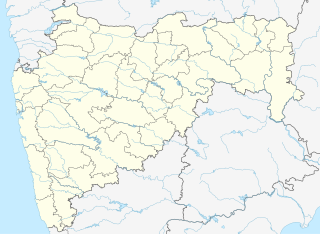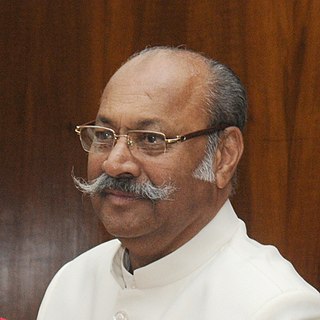Desh or Desha is a region adjacent to the Western Ghats between the Godavari River and Krishna River, a part of Deccan plateau, in the states of Maharashtra, Karnataka and Andhra Pradesh. The region is hilly and slopes towards the east, and is drained by the upper reaches of the Godavari and Krishna rivers and their tributaries.

Satara is a city located in the Satara District of Maharashtra state of India, near the confluence of the river Krishna and its tributary, the Venna. The city was established in the 16th century and was the seat of the Chhatrapati of Maratha Empire, Shahu I. It is the headquarters of Satara Tehsil, as well as the Satara District. The city gets its name from the seven forts (Sat-Tara) which are around the city. The city is known as a Soldier's city as well as Pensioner's city.
Chhatrapati is a royal title from the Indian subcontinent that was mainly used by the Marathas. It is often taken to be the equivalent of emperor. The word ‘Chhatrapati’ is a Sanskrit language compound word of chhatra and pati (master/lord/ruler) which is considered as a symbolic representation of the protector of people. The parasol was considered a symbol of absolute, or even universal, sovereignty and consecrated kingship, and has been used by monarchies outside of the Indian subcontinent, as well. The title indicates a person who is a sovereign ruler over other princes, and not a vassal. In contrast, the Indian titles of Maharaja or Raja, Yuvraj, Rajkumar or Kumar, and Senapati, reflect a range of European equivalent meanings, from King, Crown Prince, and Prince, to Duke, Count, or Lord. Shivaji adopted 'Chhatrapati' since other titles were bestowed by other lieges and paramount rulers, like the Adilshahis or Mughals.

Tarabai Bhosale was the regent of the Maratha Empire of India from 1700 until 1708. She was the queen of Chhatrapati Rajaram Bhonsale, and daughter-in-law of the empire's founder Shivaji. She is acclaimed for her role in keeping alive the resistance against Mughal occupation of Maratha territories after the death of her husband, and acting as the regent during the minority of her son.

Satara district is a district of Maharashtra state in western India with an area of 10,480 km2 (4,050 sq mi) and a population of 3,003,741 of which 14.17% were urban. Satara is the capital of the district and other major towns include Medha, Wai, Karad, Koregaon, Dahiwadi, Koynanagar, Rahimatpur, Phaltan, Mahabaleshwar, Vaduj and Panchgani. This district comes under Pune Administrative Division along with Pune, Sangli, Solapur and Kolhapur. The district of Pune bounds it to the north, Raigad bounds it to the north-west, Solapur the east, Sangli to the south, and Ratnagiri to the west.

Koregaon is a census town and headquarters for the surrounding Koregaon Taluka in the Satara subdivision of Satara district in the Indian state of Maharashtra. It is situated on the Satara-Pandarpur road about 18 km east of Satara city, about 120 km from Pune and 267 km from Mumbai. The Koregaon railway station, situated on the Pune - Miraj line, is 2 kilometers outside the town. At a stone's throw from the railway station is Koregaon Bus Station.

Satara Lok Sabha constituency is one of the 48 Lok Sabha (parliamentary) constituencies in Maharashtra state in western India, in Satara district.

Ajinkyatara is a fort on one of the seven mountains surrounding the city of Satara in the Sahayadri Mountains of Maharashtra, India. It is a 16th-century fort that was called "Ajimtara" during Aurangzeb regime and was based on Aurangzeb son's name, Ajim. Maharani tarabai capturev

Bhairavgad is a fort in India, twenty miles south-west of Patan, Satara district of Maharashtra. The fort is situated on a peak of Sahyadri range. The fort has a temple of Bhairav (Shiva); from which it gets its name. It is located at an altitude of about 1000 meters.

Padali is a census village in the Satara district, in the Indian state of Maharashtra. It is surrounded by a Mountains on its three sides. There is a big temple of Heljaidevi Mandir at Village. Agriculture is the main occupation in the village with more than 75% of the total area being used for agricultural activities.
The Venna River rises in Mahabaleshwar, and is a tributary of the Krishna River in Satara district of western Maharashtra, India. It rises near Mahableshwar, a famous hill station in the Western Ghats. The river meets the Krishna River and this confluence takes place at Sangam Mahuli which is located in eastern part of Satara city. The River Krishna is one of the three largest rivers in southern India.

Pratap Singh Bhosale was the last Chhatrapati of the Maratha Empire, Satara from 1808 to 1819. However, political power was under the control of Peshwas. He was also the Raja of Satara until 1839, when he was replaced with Shahaji of Satara by the British.
Shahu Bhonsle II was the titular Chhatrapati of the Maratha Empire. A member of the Bhonsle clan, he was succeeded by his son Pratap Singh, Raja of Satara Shahu was nominal ruler in Maratha Empire. During his reign, the Marathas won the First Anglo-Maratha War, but lost the Second Anglo-Maratha War. Mahadaji Shinde and the Peshwa were his closest counterparts. He died on 3rd May, 1808.

The Battle of Satara was fought between the Mughal Empire and Maratha Empire between 1699–1700. The battle started when the Mughal Emperor Aurangzeb personally marched towards Satara accompanied by 10,000 Mughal soldiers. His aim was to finally capture Satara, the centre of the Maratha realm. The Mughal Emperor Aurangzeb then ordered for an attack on the fort of Satara. The Mughals destroyed major parts of the fortress and the Maratha commander Santaji Ghorpade finally surrendered on April 21, 1700. The Mughals captured the fort and the battle was a victory for the Mughals.
Wai is an assembly constituency of the Maharashtra Legislative Assembly in Satara district, Maharashtra, India.
Karad South of Maharashtra Vidhan Sabha is one of the constituencies located in the Satara district.
Karad North of Maharashtra Vidhan Sabha is one of the constituencies located in the Satara district.

Satara railway station is the main railway station in the Satara district, in the city of Satara, Maharashtra. Its code is STR. The station lies on the Pune–Miraj line of the Central Railways and is administered by the Pune Railway Division.
Sainik School Satara is one of the 33 Sainik Schools of India. It is a purely residential school for boys. The medium of instruction is English. Established by Government of India on 23 June 1961 at Satara. It is affiliated to Central Board of Secondary Education and is a member of Indian Public Schools Conference (IPSC).
National Highway 965D, commonly referred to as NH 965D is a national highway in India. It is a secondary route of National Highway 65. NH-965D runs in the state of Maharashtra in India.










